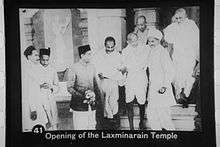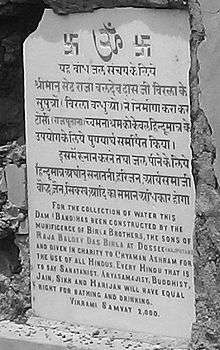Birla family
| Ethnicity | Marwari maheshwari |
|---|---|
| Current region | Operating out of Delhi, Mumbai and Kolkata, India |
| Members |
1.Shiv Narain Birla 2.Baldeo Das Birla 3.Jugal Kishore Birla Rameshwar Das Birla Ghanshyam Das Birla Braj Mohan Birla 4.Gajanan Birla Madhav Prasad Birla Lakshmi Niwas Birla Krishna Kumar Birla Basant Kumar Birla Ganga Prasad Birla 5.Ashok Vardhan Birla Sudarshan Kumar Birla Aditya Vikram Birla Chandra Kant Birla 6.Kumar Mangalam Birla Yashovardhan Birla Siddharth Birla |
| Traditions | Hindu |
The Birla family is a family connected with the industrial and social history of India.[1][2][3]
The main branch of the Birla family are descendants of Seth Shobharam, grandson of Seth Bhudharmal, a member of the Maheshwari Marwari community from Pilani in the westerly state of Rajasthan . Shiv Narain (1840–1909) was the son of Shobharam.[4][5] Shiv Narain Birla, traded in cotton and laid the foundation of the family's future business success by moving to Bombay in 1863 and establishing Shivnarayan Baldevdas, a trading house in Bombay in 1884. His son, Baldeo Das Birla moved to Calcutta set up Baldevdas Jugalkishor in 1887. Baldeo Das was succeeded by four sons [6]– Jugal Kishore, Rameshwar Das, Ghanshyam Das and Braj Mohan.[7][8][9]
Baldeo Das was awarded the Raibahadur title in 1917. In 1920 he retired from business and started living in Banares pursuing religious studies. In 1925 he was awarded the title of "Raja" by the government of Bihar and Orissa.[10] He was awarded D. Litt. by Beneras Hindu University.
Ghanshyam Das Birla laid the foundation of his industrial empire by establishing GM Birla Company, trading in jute, in 1911. The First World War began in 1914 greatly increasing the demand for jute sacks. It is estimated that during the war, the Birla worth rose from Rs 20 lakh to 80 Lakh.[11] In 1919, he became among the first group of Indian entrepreneurs to become owner of a Jute mill named Birla Jute.[12] In the next few years he acquired several cotton mills. He later started several sugar mills. The publication Hindustan Times was co-founded by GD Birla in 1924 and fully acquired by him in 1933. Hindustan Motors was started in 1942. After India's independence in 1947 he started Grasim (Gwalior Rayon Silk Manufacturing, 1948) and Hindalco (Hindustan Aluminium Company 1958) among others.
Baldeo Das, as well his sons were among the key supporters of the swaraj movement led by Mahatma Gandhi, in addition to being dedicated Hindu activists. They were active supporters of the Banaras Hindu University founded by Pt. Madan Mohan Malaviya and were also financial supporters of activities initiated by Mahatma Gandhi.[13] Mahatma Gandhi was requested to inaugurate the landmark Laxminarayan Temple in Delhi, and as asked by Gandhi, all Hindus, including harijans were welcomed.
In the few decades before India's independence, Indian merchants, including the Birlas, made successful attempts to enter and acquire industries in India which were once dominated by Scots from Britain.[14] This became a part of Mahatma Gandhi's Swadeshi movement.
Birlas remained close to some of the leaders of India, like Sardar Patel after India's independence.[15] As leading industrialists, they were often accused by the leftists of exploiting their workers and aspiring to be among the richest in the world. Still when E. M. S. Namboodiripad became the chief minister of Kerala (1957–59), as a result of the first elected Marxist government anywhere, Birlas were invited to establish a pulp factory there.[16]
In recent past, the Birlas, as well as several other Indian industrialists have expanded overseas. [17]
Family Tree of Male Members[18][19]
| Family of Birla family | |||||||||||||||||||||||||||||||||||||||||||||||||||||||||||||||||||||||||||||||||||||||||||||||||||||||||||||||||||||||||||||||||||||||||||||||||||||||||||||||||||||||||||||||||||||||||||||||||||||||||||||||||||||||||||||||||||||||||||||||||||||||||||||||||||||||||||||||||||||||||||||||||||||||||||||||||||||||||||||||||||||||||||||||||||||||||||||||||||||||||||||||||||||||||||||||||||||||||||||||||||||||||||||||||||||||||||||||||||||||||||||||||||||||||||||||||||||||||||||||||||||||||||||||||||||||||||||||||||||||||||||||||||||||||||||||||||||||||||||||||
|---|---|---|---|---|---|---|---|---|---|---|---|---|---|---|---|---|---|---|---|---|---|---|---|---|---|---|---|---|---|---|---|---|---|---|---|---|---|---|---|---|---|---|---|---|---|---|---|---|---|---|---|---|---|---|---|---|---|---|---|---|---|---|---|---|---|---|---|---|---|---|---|---|---|---|---|---|---|---|---|---|---|---|---|---|---|---|---|---|---|---|---|---|---|---|---|---|---|---|---|---|---|---|---|---|---|---|---|---|---|---|---|---|---|---|---|---|---|---|---|---|---|---|---|---|---|---|---|---|---|---|---|---|---|---|---|---|---|---|---|---|---|---|---|---|---|---|---|---|---|---|---|---|---|---|---|---|---|---|---|---|---|---|---|---|---|---|---|---|---|---|---|---|---|---|---|---|---|---|---|---|---|---|---|---|---|---|---|---|---|---|---|---|---|---|---|---|---|---|---|---|---|---|---|---|---|---|---|---|---|---|---|---|---|---|---|---|---|---|---|---|---|---|---|---|---|---|---|---|---|---|---|---|---|---|---|---|---|---|---|---|---|---|---|---|---|---|---|---|---|---|---|---|---|---|---|---|---|---|---|---|---|---|---|---|---|---|---|---|---|---|---|---|---|---|---|---|---|---|---|---|---|---|---|---|---|---|---|---|---|---|---|---|---|---|---|---|---|---|---|---|---|---|---|---|---|---|---|---|---|---|---|---|---|---|---|---|---|---|---|---|---|---|---|---|---|---|---|---|---|---|---|---|---|---|---|---|---|---|---|---|---|---|---|---|---|---|---|---|---|---|---|---|---|---|---|---|---|---|---|---|---|---|---|---|---|---|---|---|---|---|---|---|---|---|---|---|---|---|---|---|---|---|---|---|---|---|---|---|---|---|---|---|---|---|---|---|---|---|---|---|---|---|---|---|---|---|---|---|---|---|---|---|---|---|---|---|---|---|---|---|---|---|---|---|---|---|---|---|---|---|---|---|---|---|---|---|---|---|---|---|---|---|---|---|---|---|---|---|---|---|---|---|---|---|---|---|---|---|---|---|---|---|---|---|---|---|---|---|---|---|---|---|---|---|---|---|---|---|---|---|---|---|---|---|---|---|---|---|---|---|---|---|---|---|---|---|---|---|---|---|---|---|---|---|---|---|---|---|---|---|---|---|---|---|---|---|---|---|---|---|---|---|---|---|---|---|---|---|---|---|---|---|---|---|---|---|---|---|---|---|---|---|---|---|---|---|---|---|---|---|---|---|---|---|---|---|---|---|---|---|---|
| |||||||||||||||||||||||||||||||||||||||||||||||||||||||||||||||||||||||||||||||||||||||||||||||||||||||||||||||||||||||||||||||||||||||||||||||||||||||||||||||||||||||||||||||||||||||||||||||||||||||||||||||||||||||||||||||||||||||||||||||||||||||||||||||||||||||||||||||||||||||||||||||||||||||||||||||||||||||||||||||||||||||||||||||||||||||||||||||||||||||||||||||||||||||||||||||||||||||||||||||||||||||||||||||||||||||||||||||||||||||||||||||||||||||||||||||||||||||||||||||||||||||||||||||||||||||||||||||||||||||||||||||||||||||||||||||||||||||||||||||||
Philanthropy

Birla philanthropy began in the 1880s, when the Birla family donated over Rs.1 lakh for setting up goshalas (shelters for the protection of cows) in Kolkata. By early 1900, the Birla family began to support education, influenced by Pandit Madan Mohan Malaviya. They supported educational charities in Kolkata and in Mumbai teaming up with Jamnalal Bajaj. In 1918, the family established the first high school in Pilani which evolved into BITS Pilani, a prestigious institution which now has branches in Hyderabad, Goa and Dubai. They also opened a Sanskrit library in Benares and a library in Kolkata.[20] It is well known for the financial support of Indian's freedom struggle and for building temples (see Birla Temple) in several major Indian cities.
The institutions founded by the Birlas include:
- Birla Planetariums
- Guru Hanuman Akhara
- Aditya Birla Memorial Hospital
- Birla Institute of Technology and Science, Pilani
- Birla Institute of Management Technology (BIMTECH), Greater Noida[21]
- Birla Institute of Technology, Mesra
- M. P. Birla Foundation Higher Secondary School
- Technological Institute of Textile & Sciences, Bhiwani
- M. P. Birla Institute of Fundamental Research
- BK Birla Group institutions, Aditya Birla Group Institutions
- K. K. Birla Foundation, established in 1991 by Krishna Kumar Birla, gives the annual awards like Saraswati Samman, Vyas Samman and G.D. Birla Award for Scientific Research.[22]

Birla values
In a letter, Ghanshaym Das offered this advice to Aditya when he was studying at MIT:
- “eat only vegetarian food, never drink alcohol or smoke, keep early hours, marry young, switch-off lights when leaving the room, cultivate regular habits, go for a walk everyday, keep in touch with the family, and above all, don’t be extravagant.” [23]
GD Birla instructed his son Basant Kumar to 'never utilize wealth only for fun and frolic,' to 'spend the bare minimum on yourself,' and to deride 'worldly pleasures.'[24]
This advice symbolised the ethic of the rising Marwari community, with restraint and austerity its defining attributes.[25]
Birla Family ties
Although the Birlas are perceived as a single entity, the different branches of the family are now financially independent.[26][27] However they have continued to maintain family relationships that go back to the times when "Birla Brothers" were an actual entity and Raja Baldevdas was still alive.
Both of GD Birla's wives died early because of tuberculosis (He remarried after the death of his first wife), a common affliction at that time. The families of his brothers Brij Mohan and Rameshwar Das Birla helped in raising his children. When Yash Birla's parents died in a plane crash, Priyamvada Birla, ("Badi Ma") helped take care of him.[28]
It is reported that Kumar Mangalam Birla had dipped into his own resources to help his beleaguered relative Yash with his financial issues with creditors, in order to preserve the family name.[29]
"Tata-Birla" word pair
For many decades the extreme wealth in India was associated with the Tatas and Birlas. The words Tata-Birla were often used together.[30] They were distantly followed by Dalmias (Dalmia-Sahu Jain group) for some time,[31] however Tatas and Birlas have been able to sustain themselves as among the most prominent industrialists in India (for 1939-1997 data see[32]) while others have declined.[33][34]
A plan for development of India was developed by a group of industrialists in 1944, which was termed the Tata-Birla plan or the Bombay plan,[35] which is said to have served as a blueprint for India's first five-year plan.
Two South India comedy movies Tata Birla Madhyalo Laila and Tata Birla use the word pair. It also occurs in some songs.[36]
References
- ↑ "Archived copy". Archived from the original on 2011-11-29. Retrieved 2011-11-29.
- ↑ CK Birla Group - US$1.6 billion diversified conglomerate that has a history of enduring relationships with renowned global companies
- ↑ Yash Birla's business comes under stress | Business Standard
- ↑ Maheshwari Jati Ka Itihas, Maheshwari History Office, Bhanpura, Birla, June 1940, p. 183–190
- ↑ Brushes With History, Krishna Kumar Birla, Penguin UK, 2009
- ↑ The story of the Birla empire by Talveen Singh, May 31, 2011
- ↑ The Birla Family Crisis - Case Studies, Case Study in Business, Management|Case Studies Archived July 14, 2014, at the Wayback Machine.
- ↑ Battle for Billions: Birlas vs Lodhas : The Big Story – India Today
- ↑ What keeps the Marwaris thriving? – The Times of India
- ↑ Industrial Entrepreneurship of Shekhawati Marwaris, D.K. Taknet, Kumar Prakashan, Jaipur, 1987, p. 41
- ↑ India's Industrialists, Volume 1, Margaret Herdeck, Gita Piramal, Lynne Rienner Publishers, 1985 p. 63
- ↑ 'Family' spirit and frugality help the Birlas keep pace with changing times, ET Bureau, September 5, 2014
- ↑ Business Legends, Gita Piramal, Penguin UK, Dec 1, 2010
- ↑ BRITISH INVESTORS SEE PERIL IN INDIA; Managing Agents Fear Loss of Immense Profits on Half of Country's Industries NATIVES SEEK BUSINESSES Huge Sterling Credits Already Available to Buy Out the Foreign Companies, HERBERT L. MATTHEWS, THE NEW YORK TIMES. January 02, 1943
- ↑ Debajyoti Burman, Mystery of Birla House, Jugabani Hahitya Chakara, 3rd reprint 1951, P. 111
- ↑ Phrases And Facts: About Kerala, PARTHA CHOUDHURI, Liberation, Vol. II, No.3 (January 1969).
- ↑ A crisis of leadership, GITA PIRAMAL, October 1999, FAMILY BUSINESS, a symposium on the role of the family in Indian business
- ↑ This follows the common conventions. KK Birla’s daughters Nandini Nopany, Jyotsna Poddar and Sobhana Bhartia, and BK Birla has two daughters, Manjushree Khaitan and Jayashree Mohta have inherited roles in some of their fathers' businesses or charities.
- ↑ In a First, a Daughter’s Son Rises at Birla Abode, ANURADHA HIMATSINGKA, The Economic Times Mumbai, Jul 4, 2011
- ↑ Giving is in fact living, Rajashree Birla, OCT 03 2014
- ↑ http://bimtech.ac.in/about/the-legacy-the-birla-group/
- ↑ "Govind Mishra gets Saraswati Samman 2013 for novel 'Dhool Paudhon Par'". Daily News & Analysis. 22 September 2014. Retrieved 2014-09-23.
- ↑ India's Industrialists, Volume 1, Margaret Herdeck, Gita Piramal, Lynne Rienner Publishers, 1985 p. 97
- ↑ 'Family' spirit and frugality help the Birlas keep pace with changing times ET Bureau Sep 5, 2014
- ↑ Medha M. Kudaisya, The life and Times of G.D. Birla, Oxford University Press, New Delhi, 2003
- ↑ `Mahatma was witness to Birla clan partition' The Hindu Business Line, Aug. 25
- ↑ The grand partition, After months of tension, Birlas part ways amicably, T.N. Ninan, India Today September 30, 1987
- ↑ Yash gets candid, MADHUMITHA SRINIVASAN, The Hindu, April 5, 2014
- ↑ Family Values, By MiD DAY Correspondent, 01-Nov-2013
- ↑ Capitalists of the world, unite! Mathrubhumi, OCTOBER 09, 2008 Archived April 2, 2015, at the Wayback Machine.
- ↑ World Marxist Review, Volume 13, Progress Books., 1970, p. 91
- ↑ A History of Corporate Governance around the World: Family Business Groups to Professional Managers, National Bureau of Economic Research Conference Report, Editor Randall K. Morck, University of Chicago Press, 2007 p. 291
- ↑ The Curse of too-many Sons, Swaminathan S. Anklesaria Aiyar, Times of India, Nov 9, 1997
- ↑ The Rise, Fall & Rise Of Indian Business Families, Fame’ily Feuds, Ranjit Singh, 2006
- ↑ Tata Consultancy Services Story – and Beyond, Subramaniam Ramadorai Penguin Books India, 2011, p. 184
- ↑ 'Tata Birla' song is not meant to disrespect anyone: Prakash Jha, IBN Live, Oct 04, 2012